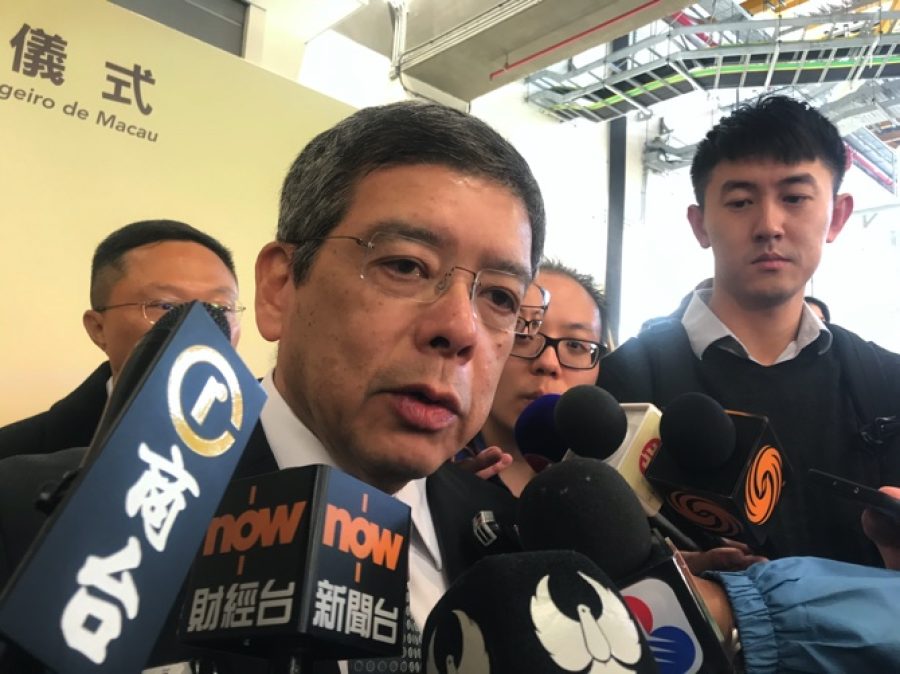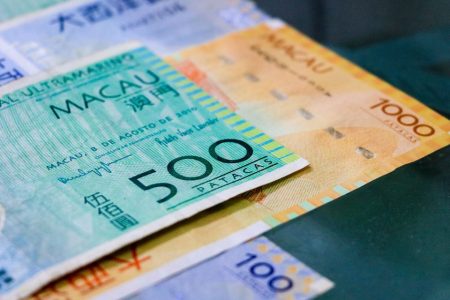Residents, many of them senior citizens, were keen to try out their free-of-charge LRT rides on the Taipa section of the long-delayed Light Rail Transit (LRT) when it finally started operating Tuesday afternoon – there was a lot of excitement in the air and just a minor glitch.
Passengers can take free LRT rides until December 31.
Macau’s first-ever railway was inaugurated yesterday morning at the LRT depot – which is located opposite Wynn Palace, before the first ride departed from the Taipa Ferry Terminal station – the eastern terminus of the Taipa section – on time at 3:33 p.m.
Residents’ enthusiasm to try out the city’s first-ever railway was visible by the long queues at the Taipa Ferry Terminal station from which the first ride departed. The first in the queue, a young man, got there at around 1 p.m. He told reporters that he is a railway enthusiast and that the opening of the LRT Taipa section is a historic moment for the city.
Outgoing Chief Executive Fernando Chui Sai On and Secretary for Transport and Public Works Raimundo do Rosário presided over yesterday’s inauguration ceremony, which was attended by senior government officials, lawmakers and community leaders.
Delivering a speech during the ceremony, Ho Cheong Kei, who heads the government-owned LRT company, said that the LRT is a “completely new” project for Macau. The government had been facing various difficulties and challenges over the past eight years during the construction of the LRT Taipa section project, Ho acknowledged, adding that the government “made progress only with great difficulty due to limited human resources.”
Ho said that the LRT Taipa section has finally been completed thanks to Chui’s support and Rosário having “taken the utmost care”.
Ho admitting that while the government made mistakes during the construction period of the Taipa section, it has gained invaluable experience, which was a “very good” reference for future LRT projects.
Speaking to reporters after the inauguration ceremony, Rosário said that “it’s finally the day” when the LRT Taipa section started operating. The policy secretary, who was reappointed by the central government to the incoming local government early this month, said that he once thought early this year that the Taipa section possibly could not open this year and that he is now very glad that the section could really open by the end of this year.
Rosário said the government estimates that the LRT Taipa section will have 20,000 passengers per day, but he was quick to add that the real number of passengers would possibly be rather different from the estimated number due to Macau’s “lack of experience” in operating a railway system.
The government announced the LRT fare system on Tuesday in a chief executive order published in the Official Gazette (BO).
Under the LRT fare system, which will take effect on New Year’s Day, passengers buying a ticket with cash will have to pay six patacas per trip when travelling up to three stations, eight patacas per trip when going up to six stations, and 10 patacas per trip when riding up to 10 stations.
The newly announced LRT fare system is different from the city’s public bus fare system which charges a single fare irrespective of the number of bus stops during a passenger’s bus ride.
Currently, all passengers paying with cash have to pay six patacas per trip on all public bus routes.
The 9.3-kilometre-long Taipa section has 11 stations.
Under the LRT fare scheme, those using a stored-value LRT card will enjoy a 50 per cent discount.
Pupils and students – holding a student version of the LRT card – will enjoy a 75 per cent discount. Children under the height of one metre don’t need to pay.
The discounted fare covers local pupils, all students enrolled in local higher education institutions and local residents enrolled in tertiary education institutions elsewhere, according to the chief executive order.
Local senior citizens aged 65 and above and the disabled – holding their respective versions of the LRT card – will be exempted from paying any LRT fares.
Rosário revealed that the government finally spent between 10.1 and 10.2 billion patacas on the LRT Taipa section – including construction, the rolling stock and the setting-up of the system – lower than the amount of 11 billion patacas announced by the current government – which started in December 2014.
Rosário said that the revenue from the fares won’t even be able cover the expenditure on the operation and maintenance of the LRT Taipa section in the short term.
According to the Macau Post Daily, Rosário said that the LRT operation and maintenance expenses include the salaries for about 600 staff members for the operation of the Taipa section, water and electricity fees, as well as maintenance costs. Electricity would cost 40 million patacas per year, he said.
An 87-year-old local woman in a wheelchair, accompanied by her son, told reporters during a trip yesterday afternoon that she was very happy to have had the chance of trying out the railway.
In a statement Tuesday evening, the government-owned LRT operator said that the operation of the LRT Taipa section was generally smooth during the first three hours after the operation started. The statement pointed out a glitch which happened at around 4 p.m., when the safety monitoring alarm of a train departing for the Taipa Ferry Terminal Station was activated when arriving at the Lotus Checkpoint Station. The statement said that to ensure safety, staff at the station arranged for all passengers to get off the train and then get on another train.
Many passengers said during their trips that the LRT is quite bumpy, particularly when going round bend.






